Have you ever been lost in a woodworking project, unsure of the right tool to use? That can be a daunting feeling. It’s like wandering through an unfamiliar forest without a map or compass.
But with the right specialty tools, you can navigate that forest like a pro and tackle any woodworking job. Just think of them as your guide, helping you find the perfect pieces and make precise cuts and joints.
From hand planes to chisels, boring bits, coping saws, joinery tools, saws, shaping tools, and sanding tools – there’s something for every type of woodworker out there!
With these trusty companions by your side, you’ll be able to conquer any challenge that comes your way.
Key Takeaways
- Specialty woodworking tools include planer blades and sanding blocks.
- Safety precautions should be taken when using specialty woodworking tools.
- Proper maintenance of specialty woodworking tools leads to a longer lifespan and better results.
- Specialty woodworking tools are important for achieving professional-looking finishes.
Hand Planes

You can’t do woodworking without hand planes, they’re essential tools for any woodworker! Hand planes are used to level, reduce thickness, and shape wood.
To properly use a plane, it must be sharpened with the right technique. Plane blades should always be kept at a 25-degree angle for the best results when smoothing or finishing surfaces. Different woods require different sharpening techniques as some woods need more aggressive cuts than others.
Additionally, it’s important to select the right type of wood for your project that requires planning. Harder woods such as oak and teak will require a higher degree of sharpening than softer woods like pine or maple.
Using the right plane and sharpening technique will ensure that you get clean cuts and smooth surfaces on your projects. It’s also important to understand which types of planes are available so you can pick one that best suits your needs when working with a particular type of wood.
From block planes to jack planes, there are many different varieties of planes that work well in different scenarios depending on what kind of surface finish is required for your project.
With all these considerations in mind, hand planes can be an invaluable tool to have in any workshop! A router bit is another essential tool for creating detailed shapes and intricate designs in wooden pieces.
Router Bits
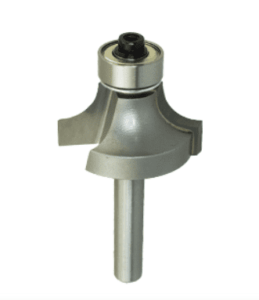
Router bits are essential pieces of equipment for precision cutting. They come in different shapes and sizes, so it’s important to know which type you need before beginning a project. Using router bits can be dangerous if they’re not used properly, so safety must be taken into consideration at all times when using these tools.
When working with wood, different types of router bits should be used depending on the type and hardness of the material being worked with. For example, carbide-tipped router bits are best for hardwoods, while high-speed steel is better suited for soft woods such as pine or fir.
When using router bits, it’s also important to make sure that they’re kept sharp and clean. This will ensure a cleaner cut and less risk of injury or damage to the project or yourself. Additionally, router bit speeds should be adjusted according to the material being cut, so that unnecessary wear doesn’t occur. Finally, routers should always have an appropriate guard installed to protect them from flying debris during operation.
Chisels are another tool used in woodworking projects with many applications, including trimming edges and removing unwanted pieces of wood from joints or other surfaces.
Chisels
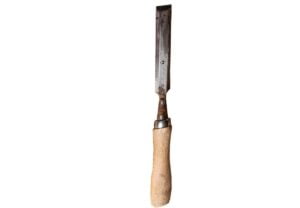 Chisels are essential for precise cutting and sculpting, allowing you to create intricate designs and shapes. Woodworking chisels come in various sizes, from 1/4′ to 1′ wide, with a variety of handles. The heavier chisels are better suited for larger projects while the lighter ones can work on smaller details. It’s important to select a chisel that’s comfortable and fits your hand well, as it’ll make the job easier.
Chisels are essential for precise cutting and sculpting, allowing you to create intricate designs and shapes. Woodworking chisels come in various sizes, from 1/4′ to 1′ wide, with a variety of handles. The heavier chisels are better suited for larger projects while the lighter ones can work on smaller details. It’s important to select a chisel that’s comfortable and fits your hand well, as it’ll make the job easier.
When selecting wood for your project, consider the type of grain – softer woods like pine or cedar are good choices.
Sharpening techniques are key when using chisels – use quality sharpening tools such as stones or diamond hones to create a razor-sharp edge that’ll be durable and reliable. First, sharpen the beveled side until it’s sharp enough to shave paper; then hone both sides of the blade with different grits, including fine honing for a polished surface finish. Make sure to protect yourself by wearing safety glasses when using power tools or grinding wheels.
When working with chisels, always keep them away from moisture so they don’t rust or corrode over time; store them in an oiled cloth bag when not in use and periodically lubricate them with mineral oil or paraffin wax during extended periods of storage. Also, practice proper technique when using these tools – push slightly against the material being cut but never force it too hard as this could damage both the tool and material being worked on.
Using quality tools, proper technique, and following wood selection tips can help you achieve successful results that’ll last a lifetime! With these tips in mind, you’ll soon become an expert at creating beautiful pieces with your woodworking projects through precise cutting and sculpting with chisels – transitioning easily into boring bits that can be used for similar tasks on larger-scale pieces of woodwork.
Boring Bits
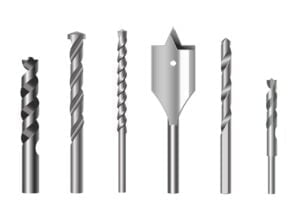 Boring bits are essential for those looking to make extra-large cuts and create intricate details in woodworking projects. They’re the true masters of carving deep, awe-inspiring grooves and holes! These handy tools come in a variety of shapes and sizes, making them incredibly versatile for any kind of job.
Boring bits are essential for those looking to make extra-large cuts and create intricate details in woodworking projects. They’re the true masters of carving deep, awe-inspiring grooves and holes! These handy tools come in a variety of shapes and sizes, making them incredibly versatile for any kind of job.
Boring bits can be used with handheld drills, drill presses, or even mounted on drill stands. They also need to be kept sharp for optimum performance – this requires regular sharpening between uses.
The key to using boring bits effectively is knowing which materials work best with each bit. Choose a bit designed specifically for the material you’re working on: hardwoods require larger diameter bits, while softer woods require smaller ones. Knowing how much pressure to use when drilling is also important – too much force will cause the bit to dull quickly, while too little won’t penetrate deeply enough into the material.
Finally, it’s important to remember that safety should always come first when using these tools. Always wear protective gear such as gloves and safety glasses when operating a drill press or other equipment with boring bits attached – an accident can cause serious injury if proper precautions aren’t taken.
With these tips in mind, you’ll have no trouble carving out precise details in any project you tackle! Transitioning seamlessly into coping saws now, this tool is perfect for making curved cuts in woodwork projects!
Coping Saws
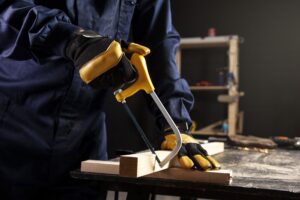
Coping saws are a great way to add intricate curves and details to your project – perfect for adding that special finishing touch! This type of saw is designed specifically for cutting curves in wood, and it features a narrow blade that’s held between two metal arms.
The arms can be adjusted to accommodate different lengths of blades, allowing you to cut through thicker materials. When dealing with snags while using the coping saw, make sure you use extra caution – never force the blade or it may break.
When selecting a blade for your coping saw, choose one made with high-carbon steel as this’ll provide the most accurate cuts. If you’re working on detailed projects such as jewelry boxes or picture frames, then consider opting for a finer-toothed blade which helps reduce splintering and ensure clean lines.
Carving tools offer an entirely new realm of creative possibilities when it comes to woodworking projects.
Carving Tools
Carving tools let you unleash your creative spirit and bring out the inner artist in you! With the right tools, you can make a masterpiece of any piece of wood.
Here are just a few carving tools that will help you create something beautiful:
- Chisels: These come in various sizes and shapes, allowing for precise cutting of hardwood.
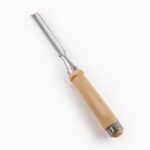
- Gouges: Used to shape or hollow out areas on the surface of the wood.
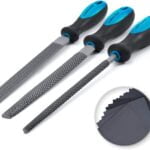
- Rasps: Ideal for fast removal of material from large surfaces or rounding off edges.
The art of carving is often used to add intricate details to furniture pieces, sculptures, and decorations. Making a masterpiece requires having the right tools as well as patience and practice.
With these items at hand, you’ll be able to make something truly unique with your own two hands! As with all types of woodworking though, safety should always be taken into consideration when using any power tool or sharp objects.
Transitioning into joinery tools offers more options for creating custom projects with ease and precision.
Joinery Tools
Joinery tools are essential pieces of equipment for any woodworker. Biscuit joiners, dowel joiners, and pocket hole jigs can help you create strong joints and precise connections between two pieces of wood. With these tools in your arsenal, you’ll be able to make beautiful projects that withstand the test of time.
Biscuit joiners
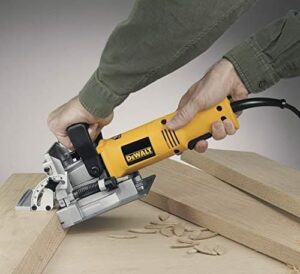
A biscuit joiner is a great tool for woodworking projects, even if you’re not an experienced carpenter – and it’s much easier to use than you think! Biscuit joiners are versatile tools that can be used to strengthen a variety of joints in your project. They are also safe and easy to use, as long as you take proper safety precautions and understand the different uses.
Here are some of the main benefits of biscuit joiners:
- Quickly Aligns Joints: A biscuit joiner helps create precise alignment when joining two pieces of wood together.
- Creates Strong Joints: The biscuit slots help hold the joint together securely and make it stronger than other forms of joining.
- Easy Setup: Set-up time is minimal since there’s no need for clamps or glue application.
- Versatile Uses: You can use biscuit joiners on both hardwoods and softwoods, as well as particle board, plywood, and more.
- Affordable Price Point: Compared to other types of joinery tools, biscuit joiners have a relatively low price point which makes them accessible for most carpenters regardless of their budget.
Biscuit Joiners are invaluable tools for any craftsperson looking to make strong joints in their projects quickly and easily – making them perfect for beginners or experienced woodworkers alike!
From here, we will transition into discussing dowel joiners which provide an alternate form of creating strong joints with minimal effort.
Dowel joiners
Using a dowel joiner is an effective way to create strong connections between two pieces of wood without needing any clamps or glue. Dowel joinery is one of the most common methods used in woodworking and involves creating wooden dowels that are inserted into pre-drilled holes in each piece of wood, then secured with glue.
The process starts by drilling holes into the edges or ends of two pieces of wood, using a drill bit that’s slightly smaller than the diameter of the dowel you’re planning on using. Once you’ve drilled your holes, use a chisel or router to clean up any rough edges inside the hole, before finishing off your wooden dowels with sandpaper for a smooth appearance.
Finally, insert them into the predrilled holes and secure them with glue for a sturdy and long-lasting joint. With proper technique and tools, achieving professional results is possible when joining two pieces together with dowels – making it an attractive option for many types of projects.
Transitioning seamlessly into pocket hole jigs is another popular tool used in woodworking to connect two pieces quickly and easily.
Pocket hole jigs
You can save time and energy when joining two pieces of wood together using a pocket hole jig – an easy-to-use tool that allows you to create strong, reliable connections in no time. This specialty woodworking tool is made up of two parts: the drill guide and the clamping mechanism.
The drill guide contains pre-drilled holes through which you can insert a specialized self-tapping screw; the clamping mechanism holds your workpiece in place while drilling. Pocket hole jigs are great for connecting boards at right angles, as they allow for precision drilling techniques and finishing techniques like countersinking and plugging.
Additionally, pocket hole jigs are relatively inexpensive and widely available, making them accessible to hobbyists and professionals alike. As one of the most versatile tools in a woodworker’s arsenal, pocket hole jigs offer an efficient way to join two pieces of wood without compromising strength or aesthetic appeal. With this handy tool, you can easily make strong joints with little effort – perfect for tackling any project!
From here we move on to saws, another essential specialty woodworking tool.
Saws
If you’re looking to start woodworking, the saw is one of the most important tools in your arsenal.
Table saws are typically stationary and used for crosscut, rip cut, and miter cuts on large pieces of wood.
Miter saws are also a common tool among woodworkers; they make accurate angle cuts with ease.
Finally, band saws are ideal for curved or irregular shapes like circles and can be used to make long straight cuts as well.
Table saws

Table saws are an essential tool for any woodworker; they’ll help you make precise cuts quickly and easily. When using a table saw, you can use drilling jigs and shaper cutters to create intricate designs with ease.
The saw blade is mounted on an adjustable arm which allows you to adjust the angle of cut for different types of cuts. Table saws also have a sliding fence that helps guide the wood when making straight or angled cuts.
A good table saw will come with various safety features such as a blade guard, a raving knife, and anti-kickback pawls to protect your hands from potential harm. You can even use a table saw to make miter joints which are perfect for framing or picture frames.
With the right setup, table saws can be incredibly versatile tools in the woodworking shop – allowing you to take on projects quickly and efficiently!
And now, let’s move on to the next type of specialty woodworking tool: miter saws.
Miter saws
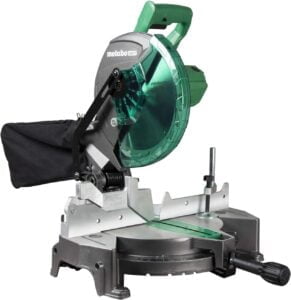
Miter saws are perfect for making quick, accurate cuts with precision – ideal for any project that requires exact measurements. They’re essential tools in a woodworker’s arsenal as they provide the ability to make angled cuts in various materials, including quality hardwoods, softwoods, MDF, plywood, and laminate.
Exploring alternatives is easy with a miter saw since it can handle different depths and widths while providing precise results. They also make it easier to achieve intricate crown molding and trim designs when working with quality materials.
Not only does this tool save time but it can also result in high-quality finished products. Transitioning from one material to another is made simple by adjusting the blade angle effortlessly without compromising the accuracy or speed of the cut.
All in all, a miter saw provides an efficient way to make exact cuts that will give your projects a professional look and feel.
Band saws
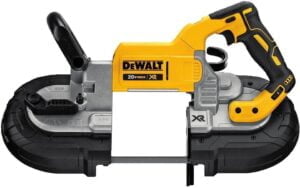
Moving on from miter saws, band saws are an essential tool for woodworking. These powerful tools allow you to make curved and angled cuts, which is incredibly useful when creating intricate designs.
Band saws come with a wide variety of blade types that can cut different angles and depths. They are great for cutting curves in thin pieces of wood and making accurate rip cuts in thick lumber. When cutting angles, the key is to adjust the blade to match the angle desired before starting the cut.
You’ll also need to consider the teeth per inch (TPI) of your blade type; coarse blades will give you rougher edges while finer blades provide more precision. With all these options available, it’s easy to see why band saws have become such a popular choice among experienced woodworkers! And with their versatility and accuracy, they’re perfect for shaping all kinds of projects – from chairs to cabinets and beyond.
Shaping Tools
Shaping tools are essential for creating custom woodworking projects – let’s explore the basics!
 One of the most common shaping tools used in woodworking is a router. Routers allow you to create intricate shapes, moldings, and joinery such as dados and rabbets. They can also be used to drill holes or create decorative edges on boards.
One of the most common shaping tools used in woodworking is a router. Routers allow you to create intricate shapes, moldings, and joinery such as dados and rabbets. They can also be used to drill holes or create decorative edges on boards.
Other popular shaping tools include:
- Spindle sander: For sanding tight curves into your wood pieces
- Drum sander: For flattening large surfaces quickly
- Hand planers: For removing material from a board’s surface
- Chisels: For removing material in hard-to-reach areas
Drilling techniques will often be necessary before using these tools, and finishing techniques are important for giving your project that perfect look.
With practice and experience, you can become an expert at using these shaping tools to make any kind of project you desire! As with any tool, safety should always come first when working with shaping tools. Be sure to wear safety glasses and use clamps securely while cutting. With proper precautionary measures taken, you’ll be ready to take on any task with confidence.
Sanding helps smooth out rough surfaces left by other shaping processes – let’s take a look at how sanding works!
Sanding Tools

Sanding is an essential step for achieving the perfect finish on your project, so it’s important to have the right sanding tools at your disposal! Several different types of sanders are available, including planer blades and sanding blocks.
Planer blades are a type of woodworking tool that is used to cut away excess material to create a smooth surface. They can be used in conjunction with other tools such as routers or saws.
Sanding blocks come in various shapes and sizes, and they are great for getting into tight corners or detailed work.
When looking for a good sander, it’s important to consider factors such as speed and accuracy. If you’re working on large projects, you may want to opt for a power sander that offers more speed than manual sanders do. For smaller projects, however, manual sanders may be just what you need to get the job done right. Additionally, some manual sanders offer adjustable levels of aggressiveness which allow you to customize the amount of material being removed from each pass over the workpiece.
No matter which type of sander you choose, it’s always important to use caution when handling them as they can cause serious injury if not handled properly. To ensure safety while working with these tools, always wear safety goggles and gloves when using them and make sure that all materials being worked on have been secured firmly before beginning any project involving them.
Properly maintained tools will last longer and will produce better results than those that aren’t taken care of properly.
With the right knowledge about specialty woodworking tools like planer blades and sanding blocks along with proper safety precautions taken every time they’re used, anyone can achieve professional-looking finishes quickly and easily!
Frequently Asked Questions
What is the best type of wood to use for a particular project?
For your project, the best type of wood to use depends on the painting and sanding techniques you plan to use. Consider how well each type absorbs stain or paint, as well as its durability for sanding. Look for a wood that matches your desired look and is suited to the techniques you plan to employ.
How much time does it take to learn how to use specialty woodworking tools?
Do you want to become a master woodworker? Learning how to use specialty tools and mastering techniques takes time, but with a careful selection of materials, you can shorten the process. Invest in quality tools and practice regularly to hone your skills.
What safety precautions should be taken when using specialty woodworking tools?
Always use proper storage and personal protective equipment when working with specialty woodworking tools. Wear safety glasses, gloves, and a dust mask to protect yourself from hazards while using these tools.
What is the best way to sharpen specialty woodworking tools?
Maintaining blades and choosing the right sharpening tool are essential for getting the best results from your specialty woodworking tools. Use a fine stone or diamond file to keep them sharp and ready for use.
What is the most cost-effective way to purchase specialty woodworking tools?
“Buy smart and save big! When selecting specialty woodworking tools, consider your buying tips and take time to compare prices. Shop around for the best deals and don’t be afraid to ask questions; an informed consumer is a smart one!”
Conclusion
You’ve come to the right place for all your specialty woodworking tool needs!
From hand planes and router bits to chisels and boring bits, these tools will make any project a breeze.
Coping saws, joinery tools, saws, shaping tools, and sanding tools are all essential pieces of equipment for any serious woodworker.
Now that you have a better understanding of what specialty woodworking tools are available, you can get started on creating your masterpiece with confidence!
With so many amazing options at your fingertips, it’s almost like having unlimited power when it comes to crafting something beautiful out of wood!

